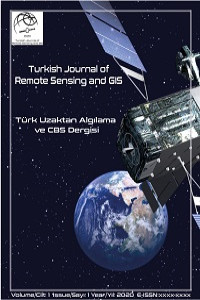Öz
Bu makalede, iç ve dış çarpım işlemlerini ve bunların tanımladığı iç ve dış çarpım uzaylarının birleştirilmesine olanak sağlayan yeni bir geometri ve bu geometrinin kuruluşunu sağlayan cebir anlatılmıştır. Geometrik cebir adı verilen bu yeni yaklaşım, Clifford cebri olarak da anılmaktadır. Kuaternionlardan daha etkili dönme özellikleri ve tensörlerden daha kolay anlaşılır yapısı ile geometrik cebrin mühendislik alanlarında büyük yenilikler getireceği değerlendirilmektedir. Bu yapının kolay anlaşılabilmesi için gerekli olan ilk kurucu aksiyomların anlaşılması ve bunlarla cebrin nasıl bir düşünce yapısı ile kurulduğunun ortaya konması gerekir. Bu makalede, bu ilk kurucu aksiyomlar ele alınmış ve cebrin kuruluşu anlatılmıştır. Bir kez cebir oluşturulunca, bu cebri daha üst boyutlara genellemek mümkündür. Klasik cebrik yapılarla anlaşılması güç hatta kimi zaman olanaksız olan üst boyutlardaki bazı ilişkilerin açıklanması geometrik cebir ile kolaylaşmaktadır. Örneğin projektif geometri 4-boyutlu geometrik cebrik uzayla, konformal geometri 5-boyutlu geometrik cebrik uzayla kurulabilmekte ve bu uzaylardaki tüm ilişkiler ifade edilebilmektedir. Makale bu konulara girilmeden, geometrik cebrin tanıtılmasını, aksiyomlarla cebrin kuruluşunu ve bu sayede temel mantığının kolay anlaşılmasını amaçlamıştır.
Anahtar Kelimeler
Kaynakça
- Artin, E. (2016). Geometric Algebra. Dover Publications.
- Bayro-Corrochano, E.,& Scheuermann, G. (2010). Geometric Algebra Computing: in Engineering and Computer Science. Springer London.
- Dorst, L., Fontijne, D., & Mann, S. (2010).Geometric Algebra for Computer Science: An Object-Oriented Approach to Geometry. Elsevier Science.
- Du Val, P. (1964). Homographies, Quaternions, and Rotations. Clarendon Press.
- Grassmann, H. (1844). Die Wissenschaft der extensiven Grössen oder die Ausdehnungslehre Erster Teil, die lineale Ausdehnungslehre. Verlag von Otto Wigand.
- Grove, L.C. (2002). Classical Groups and Geometric Algebra. American Mathematical Society.
- Hestenes, D., & Sobczyk, G. (2012). Clifford Algebra to Geometric Calculus: A Unified Language for Mathematics and Physics. Springer Netherlands.
- Hestenes, D. (2003). Oersted Medal Lecture 2002: Reforming the mathematical language of physics. American Journal of Physics, 71(2), 104–121.https://doi.org/10.1119/1.1522700
- Hitzer, E., Nitta, T., & Kuroe, Y. (2013). Applications of Clifford’s Geometric Algebra. Advances in Applied Clifford Algebras, 23(2), 377–404.https://doi.org/10.1007/s00006-013-0378-4
- Kanatani, K. (2015). Understanding Geometric Algebra: Hamilton, Grassmann, and Clifford for Computer Vision and Graphics. CRC Press.
- Khan, P.W., Byun, Y-C., & Latif, M. A. (2020). Clifford Geometric Algebra-Based Approach for 3D Modeling of Agricultural Images Acquired by UAVs. IEEE Access, 8, 226297–226308.
- Perwass, C. (2009). Geometric Algebra with Applications in Engineering. Springer Berlin Heidelberg.
- Vince, J. (2008). Geometric Algebra for Computer Graphics. Springer London.
- Vince, J. (2009). Geometric Algebra: An Algebraic System for Computer Games and Animation. Springer London.
Öz
In this paper algebraic construction of a novel geometry, which unifies inner and outer product spaces, as well as inner and outer product operations have been explained. This novel approach is called geometric algebra and also referred as Clifford algebra in the literature. It is expected that geometric algebra will bring novelties to engineering fields with its more effective rotation properties than quaternions and easier structures than tensor algebra. For easy understanding of the structures of the geometric algebra, its first constructive axioms and their use for constructing the algebra, should be clearly understood. In this paper, those constructive axioms are defined and explained how to use them to construct the geometric algebra. Once the algebra is constructed, it is straight to generalize it to upper dimensional spaces. With geometric algebra, it is easier to explain geometric relationships in the upper dimensions than classical algebras, also in situations that the classical approaches are insufficient. For example, the projective geometry can deeply be analyzed by compact structure of the geometric algebra in 4-dimensional algebraic space. In 5-dimensional geometric algebraic space, analysis of the conformal geometry is very effective. The paper aims at introducing geometric algebra with its constructive first axioms and explain the construction of the geometry in a tractable manner.
Anahtar Kelimeler
Kaynakça
- Artin, E. (2016). Geometric Algebra. Dover Publications.
- Bayro-Corrochano, E.,& Scheuermann, G. (2010). Geometric Algebra Computing: in Engineering and Computer Science. Springer London.
- Dorst, L., Fontijne, D., & Mann, S. (2010).Geometric Algebra for Computer Science: An Object-Oriented Approach to Geometry. Elsevier Science.
- Du Val, P. (1964). Homographies, Quaternions, and Rotations. Clarendon Press.
- Grassmann, H. (1844). Die Wissenschaft der extensiven Grössen oder die Ausdehnungslehre Erster Teil, die lineale Ausdehnungslehre. Verlag von Otto Wigand.
- Grove, L.C. (2002). Classical Groups and Geometric Algebra. American Mathematical Society.
- Hestenes, D., & Sobczyk, G. (2012). Clifford Algebra to Geometric Calculus: A Unified Language for Mathematics and Physics. Springer Netherlands.
- Hestenes, D. (2003). Oersted Medal Lecture 2002: Reforming the mathematical language of physics. American Journal of Physics, 71(2), 104–121.https://doi.org/10.1119/1.1522700
- Hitzer, E., Nitta, T., & Kuroe, Y. (2013). Applications of Clifford’s Geometric Algebra. Advances in Applied Clifford Algebras, 23(2), 377–404.https://doi.org/10.1007/s00006-013-0378-4
- Kanatani, K. (2015). Understanding Geometric Algebra: Hamilton, Grassmann, and Clifford for Computer Vision and Graphics. CRC Press.
- Khan, P.W., Byun, Y-C., & Latif, M. A. (2020). Clifford Geometric Algebra-Based Approach for 3D Modeling of Agricultural Images Acquired by UAVs. IEEE Access, 8, 226297–226308.
- Perwass, C. (2009). Geometric Algebra with Applications in Engineering. Springer Berlin Heidelberg.
- Vince, J. (2008). Geometric Algebra for Computer Graphics. Springer London.
- Vince, J. (2009). Geometric Algebra: An Algebraic System for Computer Games and Animation. Springer London.
Ayrıntılar
| Birincil Dil | Türkçe |
|---|---|
| Konular | Fotogrametri ve Uzaktan Algılama, Jeomatik Mühendisliği (Diğer) |
| Bölüm | Araştırma Makaleleri |
| Yazarlar | |
| Erken Görünüm Tarihi | 24 Mart 2024 |
| Yayımlanma Tarihi | 28 Mart 2024 |
| Gönderilme Tarihi | 7 Ocak 2024 |
| Kabul Tarihi | 27 Şubat 2024 |
| Yayımlandığı Sayı | Yıl 2024 Cilt: 5 Sayı: 1 |

Turkish Journal of Remote Sensing and GIS (Türk Uzaktan Algılama ve CBS Dergisi), Creative Commons Attribution-NonCommercial-NoDerivatives 4.0 International License ile lisanlanmıştır.


